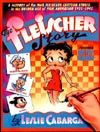
After over 30 years, Leslie Cabarga's biography The Fleischer Story remains the only book to deal in depth with the story of Max and Dave Fleischer. For that reason alone, the book is highly recommended, though it is not without its quibbles.
The book begins with the origins of the Fleischer brothers after their parents emigrated from Austria in the late 1800's. All of the Fleischers -- Max, Dave, and their lesser-known siblings Joe, Charles, Lou, and sister Ethyl -- show gifts of one sort or other. (One surprising bit of trivia is that Charles invented the "clawdigger" device still used in amusement machines.)
Early on, Max shows a gift for (and love of) mechanics and cartoons, while Dave is a very good artist. The book elaborates on how Max and Dave came in on the "ground floor" of early movie animation, eventually making their name with the Out of the Inkwell series via Max’s pioneering invention of the "rotoscope," in which cartoons could be drawn directly onto a frame of live-action film, making it look as though a cartoon figure was interacting with a human being.
From there, the book nicely details the Fleischers' successes with the cartoons of Betty Boop, Superman (in his first movie incarnation), and most famously, Popeye. According to the book, the Fleischer Studios' workers were happy practical jokers and gag-men -- until the mid-1930's, when the rise of unions in Hollywood established a combative atmosphere of "us" (the Fleischers and their supporters) vs. "them" (workers who wanted to join the union).
The studio unravels further when it is moved from New York City to Miami, Florida. In a change the book (and many Fleischer followers) attribute to the move, the gritty urban tone of the early Popeye cartoons becomes brighter and more "Disney-fied." Further adding to the Disney flavor of the Fleischer cartoons, their distributor Paramount tries to follow Disney's feature-film success of Snow White by pushing the Fleischers to do their own features, Gulliver's Travels and Mr. Bug Goes to Town.
The movies flop, and Paramount shuts the Fleischers out of their studio and moves the cartoon operation back to New York. The book's final chapters follow the Fleischers' bitter internal squabblings and career declines.
The book is far from perfect. It has countless, distracting typographical errors. And while it has numerous examples of worthwhile Fleischer artwork (character model sheets, etc.), too often such art seems to be used only as page-filler -- as when Cabarga puts the annoying equivalent of "flip-page cartoons" in the corner of several pages of the book, often overlaid atop other artwork that's more relevant to the story at hand.
(Also, readers might be at least mildly offended by a risque drawing [not the Fleischers' work] of a topless Betty Boop inserted near the end of the book.)
What comes through clearly is Cabarga's admiration for the Fleischers and their work. As with many current followers of animation, the thread that runs through Cabarga's writing is his love of the Fleischers' witty, zippy style, and the regret that their initial success ended too soon and the later appreciation of their cartoons came too late for them to enjoy it.
The Fleischer Story, like the best Fleischer cartoons, often appears ragtag but in retrospect remains far superior to other work of its period. It's as much fun as its subject matter.
My rating:


Related link:
Leslie Cabarga’s website© 2007, Steve Bailey.
Click here to go to:
Our cartoon-list page